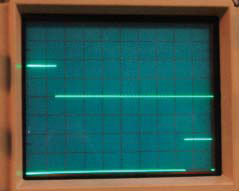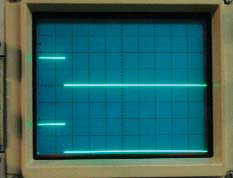 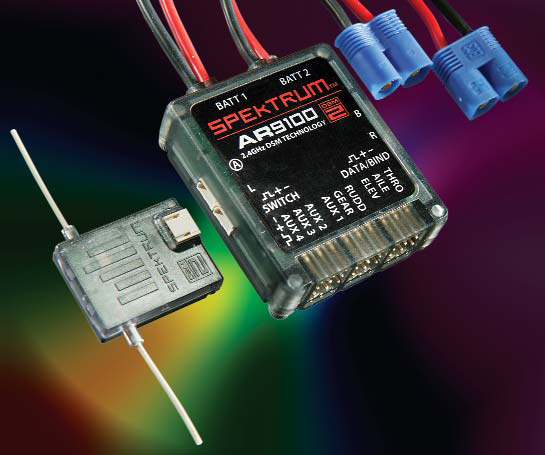 In my March/April 2005 Radio Spectrum column in RCM magazine, the topic was a truly revolutionary radio systemthe XP9303 from JR (Horizon Hobby). This 9-channel radio system has a 30-model memory and three model types (airplane, sailplane and helicopter) with virtually limitless programming options via a unique rolling selector system. This 72MHz system became my favorite; now it has been improved with a built-in 2.4 Spread Spectrum system (add-on modules for the 72 version are also available).Among the features in both the 72MHz and the 2.4GHz JR 9303 systems are servo-reversing, dual rates and exponential, programmable switch assignments, programmable trim rates, fail-safe, servo monitor display, three timers (transmitter, stopwatch and countdown timer), and a model-memory transfer/copy system that enables you to copy data from your 72MHz 9303 to your 2.4 9303. In my March/April 2005 Radio Spectrum column in RCM magazine, the topic was a truly revolutionary radio systemthe XP9303 from JR (Horizon Hobby). This 9-channel radio system has a 30-model memory and three model types (airplane, sailplane and helicopter) with virtually limitless programming options via a unique rolling selector system. This 72MHz system became my favorite; now it has been improved with a built-in 2.4 Spread Spectrum system (add-on modules for the 72 version are also available).Among the features in both the 72MHz and the 2.4GHz JR 9303 systems are servo-reversing, dual rates and exponential, programmable switch assignments, programmable trim rates, fail-safe, servo monitor display, three timers (transmitter, stopwatch and countdown timer), and a model-memory transfer/copy system that enables you to copy data from your 72MHz 9303 to your 2.4 9303.
Both systems give you a programmable trainer system that allows you to select which functions you transfer to the student. A single, 3-position flight-mode switch allows switching between modes. Many of the program features may be individually programmed for each flight mode; therefore, a flight mode is an aircraft configuration. One flight mode may be for takeoff and landing; another flight mode might be normal flight; and another may be for snappier aerobatic flight.Programmed mixes are included, and six additional programmable mixes are left to your imagination. You may mix any channel to any other channel, and you also get a snap-roll system. Servo speed can also be programmed with durations of up to 15 secondsgreat for landing-gear-door sequencing. The manual for the JR X9303 2.4 goes into all the features in detail and can be accessed at www. horizonhobby.com in the Support section. While I enjoy many features of the X9303 2.4, the model-match and dual-channel systems are among my favorites. |
|
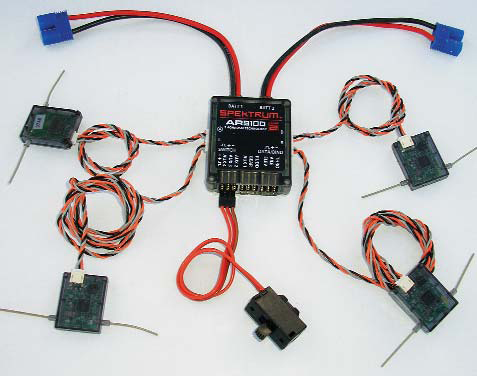 |
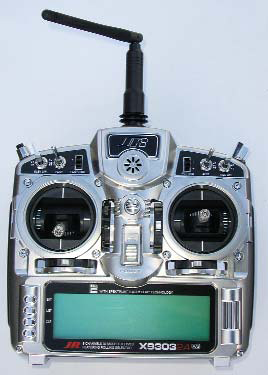 |
| The AR 9100 Power Safe receiver system with all four remote receivers (also sold under the JR brand name as the R922 receiver). The main body is a power-bus system that can handle 35 to 50 amps peak to the 9 channels of servos. A small mechanical switch plugged into the servo end of the AR 9100 turns the entire system on and off. | |
|
learns your transmitters unique code and fail-safe positions, but it also learns that model memory (a patent-pending feature called ModelMatch). If you go to the field with two airplanes and then decide to fly the second airplane but forget to select it on the transmitter, the system will not link up or operate. This beats taking off with reversed ailerons.When binding the transmitter, the button on the back is pushed and then the power is turned on. If you are doing a range check, the transmitter is turned on and then the button in the back is pushed. If your transmitter is in some sort of a stand that is pushing this button when you turn it on, the transmitter may go into bind mode and forget your receiver. Re-binding is easy: just remember to place the joysticks in the desired fail-safe positions before rebinding. Note that all your program data, reversing, rates, etc., do not have to be reprogrammed. |
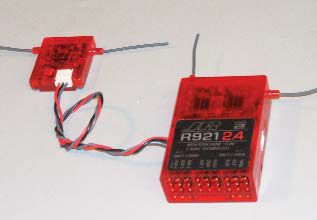 The R921 2.4GHz 9-channel receiver came with my X9303. It has two internal receivers, one remote receiver and a port for an optional fourth remote receiver. The R921 2.4GHz 9-channel receiver came with my X9303. It has two internal receivers, one remote receiver and a port for an optional fourth remote receiver. |
|
DUAL SERVO PROGRAM FOR PERFECT SERVO SYNC
The oscilloscope screen on left shows that when using a programmable mix from elevator to Aux. 3, the Aux. 3 updates 7ms after the elevator channel. The screen on the right shows that when using the 9303 dual elevator program, the gear and elevator channels are activated at exactly the same time. |
|
|
Another favorite feature is the dual-channel system. Many airplanes have a servo on each aileron, and I like a servo on each elevator half, if for no other reason than redundancy. The 9303 offers a simple, easy-to-use 2-channel mix system that can substitute for a Yharness, a conventional ad hoc mix of 2 channels, or a matchbox. Many have mixed channels where each elevator servo (for example) has its own reversing, throws, subtrim, etc. Have you realized that those servos dont operate at the same time? Our 72MHz transmitters send out a serial string of data, one channel after another, until we get back to the start of a new frame and it starts over. It only seems that we have simultaneous control of our servos. The first oscilloscope photo shows the R921 2.4GHz receivers elevator channel (top ) and auxiliary no. 3 channel (bottom). The pulses vary in width from approximately 1 to 2ms with the action of the joystick to operate the servos. There are about seven divisions between pulses, and since the oscilloscope is set to one millisecond per division (horizontally), the auxiliary channel is updated 7ms after the elevator channel. I realize this is a fine point, since even our fast servos take about 2ms per degree of rotation, but read on. Now look at the second oscilloscope photo; my two elevator pulses are on top of each other; they occur at the same time. I was able to find which channels occur simultaneously or closest in time by using the oscilloscope, and I will share this information with you. First, go to Dual Channels under Wing Type found in System Menu. If you have previously disabled the landing gear, flap, Aux. 2 and Aux. 3, those 4 channels become choices of mating channels for your aileron, elevator, rudder and flap channels. I recommend that you mate aileron with flap and elevator with gear. One elevator servo plugs into the elevator, and the other elevator servo plugs into the gear. The example in the JR manual mates the elevator channel to Aux. 3, which will work fine. And, if I were to use more than one rudder servo, I would mate rudder to Aux. 3 (they will be operated within 2.5ms of each other). |
|
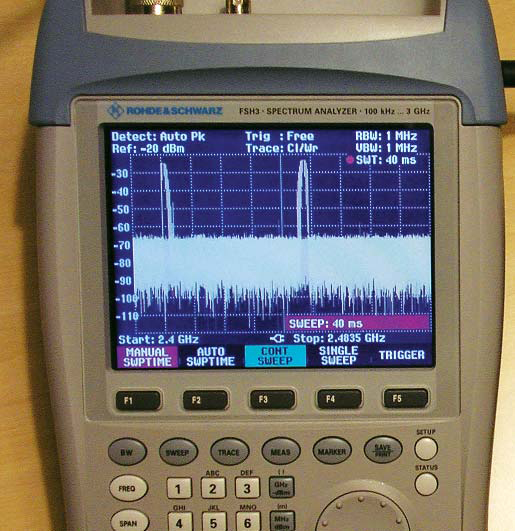 The R921 2.4GHz 9-channel receiver came with my X9303. It has two internal receivers, one remote receiver and a port for an optional fourth remote receiver. The R921 2.4GHz 9-channel receiver came with my X9303. It has two internal receivers, one remote receiver and a port for an optional fourth remote receiver. |
R921 & AR 9100 2.4GHZ RECEIVERS
The receiver that came with my system is the R921 2.4; it has two internal receivers, one remote receiver and a port for an optional fourth remote receiver. There are nine servo connectors and two battery connectors. Redundant batteries with their own switches and regulators (or some sort of isolation) can be used without using a servo port. I have tested this receiver, and it performs very well with 40 other Spektrum transmitters turned on. Read the sidebar for details on this receivers phenomenal performance. A new, 9-channel receiver system is Spektrums AR 9100 Power Safe. This unit includes the main body and up to four remote receivers, but it is sold with just three remote receivers. |
|
I cant imagine why anyone would invest in a system like this for their labor of love without spending an additional $30 for the fourth remote receiver. The main body is not an actual receiver but is a power-bus system for all 9 channels of servos. Battery power is not fed through a servo-type connector or through an unused channel; in fact, the system will not operate by plugging your standard battery into an unused servo port; the receivers themselves will not get powered up. The power to the AR 9100 is fed into the two large blue connectors with heavy wire; you may use one or both for redundancy. These blue connectors are the EC-3 connectors that are also used in E-flite (Horizon Hobby) LiPo battery packs for electric flight, but you need to be careful here. While the AR 9100 will operate on voltages of from 6 to 10 volts and can deliver 35 amps or 50 amps peak to the servos, a 2-cell LiPo pack is too much voltage for most servos unless you also use a regulator. |
|
|
TESTING WITH 40 DX7S TURNED ON! We subjected the JR R921 and AR 9100 receivers to bench tests, ground-range and flight tests with more than 40 Spektrum DX7 transmitters turned on. We measured latency, which is the time required to execute transmitter-to-servo commands. I built a circuit that plugged into the receiver in place of a servo so that the mechanical speed of a servo was not a factor. I used an analog servo amplifier whose output was connected to an LED in an opto-coupler instead of a servo motor. Then, the opto-coupler sensor signal was fed into a chip to clean up the pulse, which was immediately viewed on an oscilloscope. The receivers ground was not tied to the oscilloscopes ground and/or the transmitters ground. I took the back off each transmitter being tested and connected the oscilloscopes trigger to the back of the landing-gear switch. The landing-gear channel was used because it is a snap action; how fast I moved a joystick was not a factor. With all 40 DX7s turned on, there was no evidence of an increase in response time or latency for either the R921 or the AR 9100 receiver. Our 2.4GHz band runs from 2.400 to 2.4835 in 79 1MHz frequencies. Since the Spektrum transmitters are said to use two frequencies at once, one would think that 40 transmitters would use up the entire band. I turned on 44 Spektrum transmitters, and my test radio still didnt have any problems linking up and operating on the bench. There seems to be a time-share going on that permits more than 40 systems to be on the air.
ANTENNA EXPERIMENTS Ground-range tests were done to see whether antenna placement, orientation, or metal obstacles had an effect on range tests, and whether 40 transmitters turned on would affect range. I also tested to determine whether the maximum range was affected when the transmitters antenna was pointing at the model or if the transmitter antenna is bent at the knee so that it is at a right angle to the model. In all cases, the maximum range test showed a slight reduction in range (insignificant), as the transmitters antenna was pointing at the modeljust as has been commonly seen with 72MHz systems, but not below the recommended 30 paces. Metal barriers were placed between the transmitter and airplane; I used a large metal coffee can, a car and a large garage with a big metal door. The maximum range was reduced somewhat but never to less than the recommended 30 paces. With 40 transmitters turned on, however, the R921 started to show a range reduction to just below 30 paces. The JR 9303 2.4 system with the AR 9100 (also sold as the JR 922) Power Safe receiver system with the fourth remote receiver remained above 30 paces with all 40 DX7 transmitters turned on. This is a striking success story. FLIGHT-TESTING We flew test airplanes in a predictable manner, holding altitude and flying a repeatable big oval around the field. So that Id be able to perceive any possible receiver holds, I flew my ovals with a constant rhythmic wing rocking, left, right, left, etc. We were able to fly both receiver systems with all 40 DX7 transmitters turned on and didnt find any evidence of a hit. Spektrum offers a tool called a Flight Log that plugs into the data port of their 9-channel receivers. The Flight Log displays receiver battery voltage, the number of antenna fades for each of the (up to) four receivers, the number of lost frames and the number of holds. Neither one of these receiver systems ever went into hold. In the case of the R921 2.4 receiver, there were a few frame losses (among 18,000 frames in a 6-minute flight) as the latter half of 40 DX7 transmitters were turned on, but the receiver never went into hold. The AR 9100 Power Safe Receiver system did not lose a single frame and had zero holds. I must say, I am very impressed with the AR 9100/JR 922 Power Safe RX Systemtruly, the most robust RF link I have seen under harsh testing. I want one! Editors note: Cal Orr thanks Hobby Club USA, Ontario, California, and Steve Parola and Lonnie Morrison for four long days of help; Hobby Club USA for providing the test airplanes and fuel; the Pomona Valley Model Airplane Club in Southern California for the exclusive use of their field during the flying test; the AMA and Jay Mealy for their support and use of their 3GHz Spectrum Analyzer; and Horizon Hobbies, Eric Meyers and Steve Goodreau for providing 40+ DX7 systems and stepping back to allow truly independent tests. |
|
|
Note that the minimum voltage is 6 volts. I used two 5- cell Ni-Cd battery packs and soldered heavy wire with the mating EC-3 blue connector. Then I made an adapter from EC-3 to JR male for charging only. Also, note that E-flite sells EC-3 connectors with heavy wire for about $3. E-flite also sells EC-3 connectors in extensions and Y-harnesses; you may want to use these so that you can charge at the field without taking your model apart. You dont need switch harnesses with your battery packs; just plug the packs into the EC-3 connectors on the AR 9100. Inside the main body is an electronic switch that turns both battery packs on and off. A small mechanical switch plugged into the servo end of the AR 9100 turns the entire system on and off. The mechanical switch operates the electronic switch, and when the mechanical switch is closed, the radio system is off and it is open for on. This means that if your mechanical switch fails or you simply unplug it from the AR 9100, your system will be on.Since the AR 9100 uses an electronic switch, there is a small current draw (about 1mA) even when the system is off; therefore, if your model will be stored for some time, you might want to unplug your batteries. This 1mA discharge rate is very slow; many Ni-Cd batteries have a self-discharge rate faster than this.The receivers in the AR 9100 are all remote, and that gives you the opportunity to completely separate them from all wiring. The three remote receivers included with the system came with 9-, 12- and 24- inch extensions. I selected an 18-inch extension for my optional fourth remote receiver. Fan out these remote receivers all over the model; I suggest one in each wingtip as long as you dont have to unplug those tiny white connectors every time you remove the wing. Place the other two remote receivers in the nose and tail. In my tests, we put all four remote receivers in the fuselageone forward of the main power-bus system and the rest back at different distances from the power bus. Even with all 40 Spektrum transmitters turned on, my flight test showed no frames lost and zero holds (see sidebar above). These are much better results than I ever expected. Its hard to imagine an RF link that could be any stronger or more robust; the system is all digital, and no frames were lost.The AR 9100 Power Safe receiver system with all four remote receivers proved to have an excellent RF link in a harsh environment. I caution you not to become complacent with these systems, though, as a wiring problem, a bad servo, or a bad linkage setup can still bring your model down. Everything needs to be as good as it can beas good as the RF link in these new systems. Any thoughts, contact calorrflyrc@hotmail.com. Links JR, distributed exclusively by Horizon Hobby Distributors www.jrradios.com, (877) 504-0233 Spektrum, distributed by Horizon Hobby www.spektrumrc.com, (800) 338-4639 |
|
 Fly RC Magazine WE LIVE RC
Fly RC Magazine WE LIVE RC
